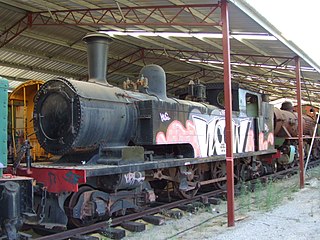Transwa is Western Australia's regional public transport provider, linking 240 destinations, from Kalbarri in the north to Augusta in the south west to Esperance in the south east.

The Prospector is a rural passenger train service in Western Australia operated by Transwa between East Perth and Kalgoorlie. On this service, two trains depart almost at the same time in opposite directions, one travelling between East Perth and Kalgoorlie, and the other between Kalgoorlie and East Perth. The original vehicles ordered in 1968 for trains providing this service were replaced in 2004 with vehicles capable of reducing journey times to 6 hours 45 minutes.

The Australind is a rural passenger train service in Western Australia operated by Transwa on the South Western Railway between Perth and Bunbury.

Australian Railroad Group (ARG) was an Australian rail freight operator. It began operations in Western Australia on 17 December 2000 following its purchase of the Westrail freight business. It was purchased by QR National in June 2006. The main commodities hauled by ARG included grain, mineral sands, alumina, bauxite, coal, woodchips, quartz, nickel and iron ore around Western Australia. In June 2011, it ceased trading as a separate brand, and became part of QR National.
Western Australian Government Railways (WAGR) was the operator of railway services in the state of Western Australia between October 1890 and June 2003. Owned by the state government, it was renamed a number of times to reflect extra responsibility for tram and ferry operations that it assumed and later relinquished. Its freight operations were privatised in December 2000 with the remaining passenger operations transferred to the Public Transport Authority in July 2003.

The Westland was the name given in 1938 to the overnight train operated by the Western Australian Government Railways (WAGR) with sitting and sleeping cars between Perth and Kalgoorlie, where it connected with the Trans-Australian service to Adelaide.
The Albany Progress was an overnight passenger train operated by the Western Australian Government Railways between Perth and Albany via the Eastern and Great Southern lines from May 1961 until December 1978.
Railways in Western Australia were developed in the 19th century both by the Government of Western Australia and a number of private companies. Today passenger rail services are controlled by the Public Transport Authority through Transperth, which operates public transport in Perth, and Transwa, which operates country passenger services. Great Southern Rail operates the Indian Pacific.

The X Class were a class of diesel locomotive built by Beyer, Peacock & Company and Metropolitan-Vickers, Bowesfield Works, Stockton-on-Tees for the Western Australian Government Railways between 1954 and 1956.

The WAGR N class was a class of steam locomotives operated by the Western Australian Government Railways (WAGR) from 1896 until 1960.

The WAGR W class was a class of 4-8-2 steam locomotives operated by the Western Australian Government Railways (WAGR) between 1951 and 1972.

The Western Australian Government Railways operated many unique steam, diesel and electric locomotive classes. Often suffering from lack of available funds the WAGR locomotive fleet often consisted of locomotives far older than their expected operational life. Only one electric locomotive was operated by the government during the WAGR years.

The WAGR P and Pr classes were two classes of 4-6-2 steam locomotives designed for express passenger service on the Western Australian Government Railways mainline network. The initial designs were prepared by E.S. Race and together the two classes had a total build number of thirty-five locomotives, the P and Pr classes entering service in 1924 and 1938 respectively. Both classes were used on express passenger services, greatly improving the economy and speed of long-distance passenger travel in Western Australia, the results of which were most visible on the West Australian stage of the Trans-Australian Railway and Westland Express.
The Esperance Branch Railway is a railway from Kalgoorlie to the port of Esperance in Western Australia.

The MRWA P class was a class of steam locomotives operated by the Western Australian Government Railways (WAGR) and later the Midland Railway of Western Australia (MRWA) from 1896.

Western Australian Government Railways railway system during its peak operational time in the 1930s to 1950s was a large system of over 6,400 kilometres (4,000 mi) of railway line.

The WAGR G class is a class of steam locomotives operated by the Western Australian Government Railways (WAGR) from 1889. The class's wheel arrangement varied; the first 24 were 2-6-0s and the last 24 4-6-0s.

The WAGR ADE class was a six member class of diesel railcars operated by the Western Australian Government Railways between 1937 and 1962.

The WAGR ADF class was a six member class of diesel railcars operated by the Western Australian Government Railways between 1949 and 1975.

The WAGR AI class was a petrol-driven railmotor or railcar operated between 1935 and 1949 by the Western Australian Government Railways (WAGR).















